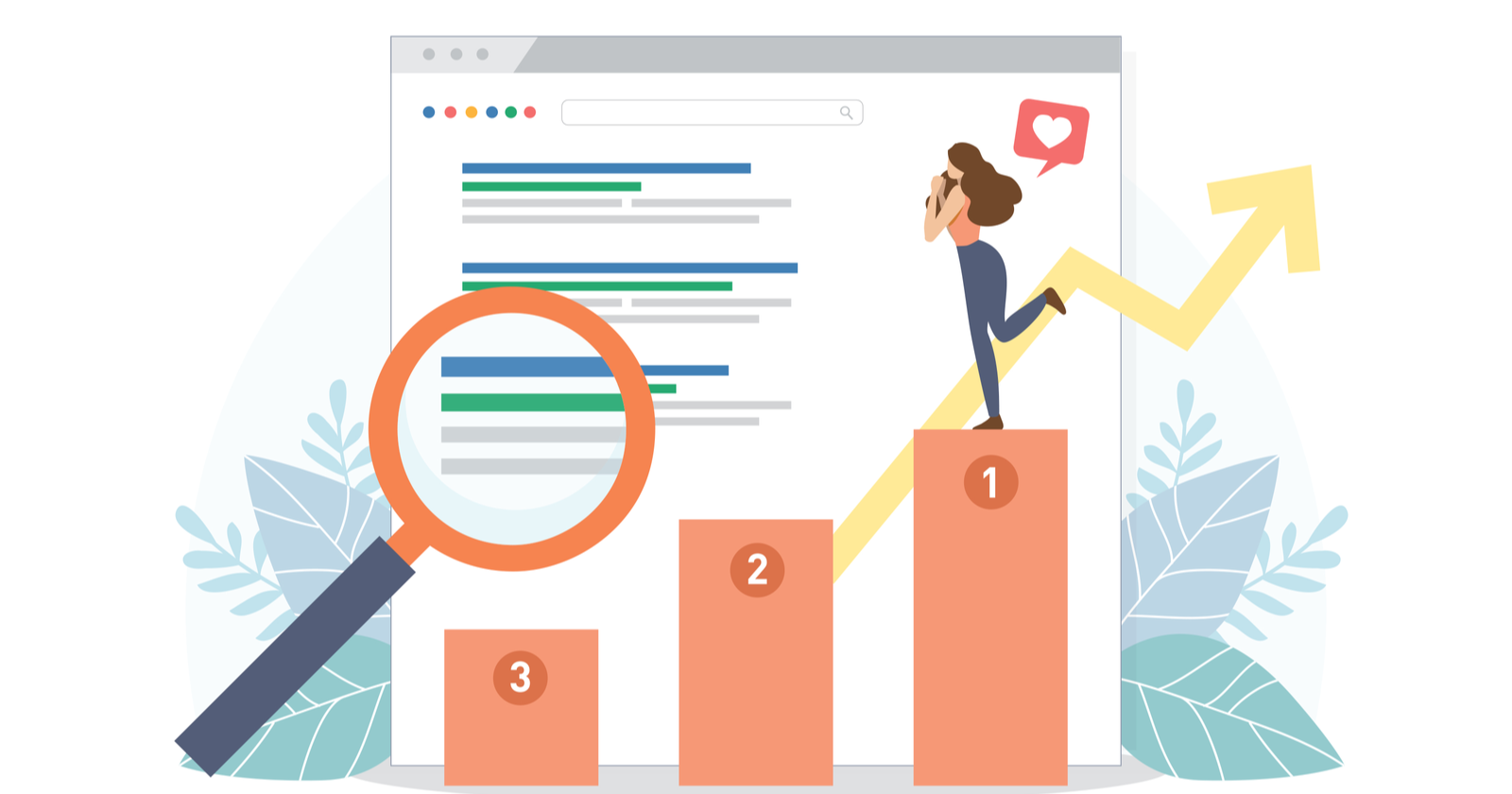SEO
10 Different Ways To Get Organic Page 1 Google Rankings

Google search has been continually evolving since the very beginning.
Over the past 10 years, much of that evolution was driven by improvements in technology but also changes in what users expect.
Here are 10 opportunities for more traffic from Google and how to get it.
Google has steadily been committed to making search results more useful and also in response to changing user behavior, lately driven by the new demands of mobile search.
With the introduction of knowledge panels in 2012 followed by featured snippets in 2014 – not to mention the local search packs that preceded that – optimizing for 10 blue links has become anachronistic.
It’s an SEO practice from the past.
Rich results, featured snippets, Map Pack results, knowledge panels, and more are opportunities for more site visitors from an increasingly dynamic search results page.
How can you compete? By staying up-to-date.
In this post, we’re going to explore the different ways you can appear on Google’s Page 1 by optimizing content for various types of search results.
Note: this is in no way comprehensive and is ever-changing, as Google constantly tests and launches new features (and sometimes takes our favorite toys away).
Core Types Of Rich Search Results
The examples below will fall into one of these categories (and there may be some overlap):
- Rich Results.
- Featured Snippets.
- Knowledge Panels.
- Local Business Results.
Rich results are enhanced organic search result that adds information to a plain text search result and expands it as a result.
Rich results make your results more dynamic, visible, and engaging.
Featured snippets are enhanced answers that appear at the top of search results (sometimes even above paid results).
Sometimes referred to as “position zero,” it’s actually position 1 out of the traditional 10 organic positions.
These results are enhanced organic search results that contain additional visual enhancement, including stars, as part of a carousel of search results and may include images from multiple websites.
-
 Screenshot from search for [wordpress stored xss vulnerability], Google, March 2022
Screenshot from search for [wordpress stored xss vulnerability], Google, March 2022
This search result typically answers an informational query and may include text, a numbered (or non-numbered) list, and images (sometimes from multiple sites).
Featured snippets make your organic search listings more dynamic, visible, and engaging.
Research data from different sources in 2020 and also 2021 estimates that featured snippets display in the search results between 11% and 19% of SERPs.
It’s important that you’re optimizing for the search results enhancements that make sense within the context of your business goals and searcher intent.
Knowledge panels are information panels about what is generally referred to as entities. What is meant by the word entities are people, places, organizations, movies, music, and other things.
Knowledge panels provide quick information about entities that are automatically generated.
The entities that are subjects of knowledge panels have the opportunity to “claim” a knowledge panel and influence the information that is in that knowledge panel.
Google also accepts user feedback about knowledge panels.
Knowledge panels are an opportunity for organizations and individuals to present their information through Google.
Google Business Profile (formerly known as Google My Business) is a Google program that allows local-based businesses to manage their online presence whenever someone searches for their business, a local product, or a service.
The data in Google Business Profile powers the local Map Pack in the organic search results.
It helps to surface the correct information in Google Maps, and it provides a way to control the business profile shown in Google’s search results including things like phone numbers, addresses, and hours.
Check out a comprehensive overview of Google Business Profile if you’re just getting started or looking for improvements in that area.
The likelihood that you’ll earn a result in one of these formats depends on hundreds of factors that only Google knows, but you can safely assume that these weigh heavily into the mix:
- Relevance to the query.
- Vertical, industry segment, or category (such as flights, hotels, or restaurants).
- Correct use of structured data.
- Content quality.
Here are 10 ways you can get more Page 1 – and Position 1 or even the coveted Position Zero – results in Google.
For each one, you’ll find tips and resources to help you optimize for that type of result (although this is in no way a guarantee that you’ll achieve it).
1. Plain Text Organic Search Results
Achieving the top plain text organic search result in Google is more difficult than ever before.
Not only is search extremely competitive, but search results consisting of just plain blue links are becoming rare for certain kinds of questions, particularly “how-to” type search queries.
As for ten blue links, those essentially don’t exist anymore on mobile devices because search results on mobile are shown with a continuous scroll so that users no longer have to click to the next page of search results.
 Screenshot from search for [should publishers use link disavow tool?], Google, March 2022
Screenshot from search for [should publishers use link disavow tool?], Google, March 2022How To Optimize For It
- Answer a searcher’s need for information.
- Be superior in every way. Seriously, that’s what it takes.
2. Video Rich Results
It’s no surprise that YouTube results feature prominently in Google’s search results.
Until last year, videos appeared as a thumbnail alongside the blue text link.
Now, Google organizes them into Video Rich Results that are sometimes displayed above the regular text link results.
 Screenshot from search for [how to cook with a wok?], Google, March 2022
Screenshot from search for [how to cook with a wok?], Google, March 2022How To Optimize For It
- Help searchers and search engines understand your video’s content with relevant, quality titles, descriptions, and tags.
- Use the appropriate VideoObject Structured Data.
3. Carousel Rich Results
Google’s documentation states that carousel rich results are available for four specific kinds of content:
- Course
- Movie
- Recipe
- Restaurant
It also appears to be available for other entertainment media besides Movies, like podcasts, and even for Victorian-era authors.
 Screenshot from search for [authors of victorian fiction], Google, March 2022
Screenshot from search for [authors of victorian fiction], Google, March 2022How To Optimize For It
4. Featured Snippet
A type of organic search result that displays approximately 50 words of text, the page title and URL, and a featured image thumbnail.
Featured snippets are an excellent opportunity to get more eyes on your thought leadership material.
 Screenshot from search for [what are google algorithms?], Google, March 2022
Screenshot from search for [what are google algorithms?], Google, March 2022How To Optimize For It
- Answer informational queries relevant to your business and its products or services.
- Keep this paragraph format and a simple Q&A approach in mind as you create content you hope to rank on this type of result.
- Do the legwork of researching what questions people have and see what results come up. Are there opportunities where no result renders? Are there results that seem low quality or outdated? Start there and use your learnings from those early efforts with the easiest opportunities to target more competitive search terms.
5. Data Table Snippet
Tables can be an effective way to share information or demonstrate concepts.
Note that Google initially developed this result for news media.
However, as brands increasingly function as publishers and may even tackle timely news stories, this could be an opportunity for businesses, as well.
Google is also able to read data that is displayed in HTML tables (without structured data) and display them as a Data Table Snippet.
 Screenshot from search for [europe search engine market share], Google, March 2022
Screenshot from search for [europe search engine market share], Google, March 2022How To Optimize For It
- Explore Google’s approach to dataset discovery and find developer resources here.
- Read more about displaying data tables in search results here.
6. Top Stories Carousel
The Top Stories carousel displays the headline, source name, and an expanded image. These results are open to blogs as well as media websites.
Proper optimization here can result in your article being automatically converted into action on Google Assistant, enabling people to access your content through the voice assistant.
 Screenshot from search for [google search label for cited sources], Google, March 2022
Screenshot from search for [google search label for cited sources], Google, March 2022How To Optimize For It
- Google will display news content in the top stories carousel regardless if the article is published in AMP or not.
- What is important is that the webpage uses the correct structured data in order to pass along relevant information that can be used to show in the Top Stories section of Google’s search results.
- Additionally, be sure to use the right size featured image. It is recommended by Google that images for AMP pages be a minimum of 1200 pixels wide.
- For non-AMP pages, Google’s article structured data developer page recommends a minimum of 696 pixels wide. However, Google’s guidelines for the Google Discover program recommend all pages use images with a minimum of 1200 pixels in width. So for Google News, it’s best to use images that are a minimum of 1200 pixels wide in order to remain eligible for being shown in Google Discover as well as Google News.
7. Local Business Knowledge Panel Card
With the proper markup and optimizations, business panels can have a great deal of functionality and interactivity.
Not only can searchers find your address, phone number, and hours of operation without clicking through to your site, but they may be able to complete actions such as booking a table, placing an order, or making an appointment.
Your panel expands as more relevant information is added, making it incredibly hard to miss on both desktop and mobile.
 Screenshot from search for [greystone prime steakhouse], Google, March 2022
Screenshot from search for [greystone prime steakhouse], Google, March 2022How To Optimize For It
- Expand your panel as much as possible by populating your Google Business Profile (GBP) with descriptive, relevant information to help searchers make a decision about your business.
- Monitor your GBP dashboard and interact regularly with searchers who leave reviews, ask questions, or otherwise attempt to engage your business.
- Keep all information up-to-date in order to avoid poor searcher experience (such as directing someone to a closed location) and eroding search engine trust in your brand.
- Find specific markup to facilitate actions such as reservation taking or online ordering here.
8. Event Rich Result
Marking up your events pages with Event Structured Data helps this information appear in Google Search and Maps results.
Searchers can also click through to see more events and filter by date.
 Screenshot from search for [concerts in boston may 2022], Google, March 2022
Screenshot from search for [concerts in boston may 2022], Google, March 2022How To Optimize For It
9. Review Snippet
When Google finds the proper markups for reviews, it may expand your rich result with a review excerpt or an average combined rating score.
Currently, this rich search result type is available for books, local businesses, movies, music, products, and recipes.
 Screenshot from search for [the fundamentals of brand SERPs for business book review], Google, March 2022
Screenshot from search for [the fundamentals of brand SERPs for business book review], Google, March 2022How To Optimize For It
- Follow Google’s instructions here for optimization whether you want to add a simple review, embed a review into another schema.org type using its review property, add ratings to your reviews, or add aggregate ratings.
10. Logo In Knowledge Panel & Search
Reinforce your branding at every opportunity by ensuring that your logo appears in your business panel and in Search.
 Screenshot from search for [bing], Google, March 2022
Screenshot from search for [bing], Google, March 2022How To Optimize For It
- Use a logo that is 112 x 112px, at minimum, in .jpg, .png, SVG or WebP format.
- Make sure that the image URL is crawlable and indexable.
- Apply the proper markup.
Overall Best Practices For Rich Search Results Optimization
- Follow Google’s structured data guidelines. It’s pretty important to them that you do so, as evidenced by their guide entitled (you guessed it): Follow the structured data guidelines.
- If you’re just getting started, try out Google’s Structured Data Codelab to experiment with several different types of structured data in a controlled, instructive environment.
- Use Google’s Rich Results Test to see if your page supports rich results and get recommendations to improve.
- Avoid being perceived by Google as a structured data spammer by resolving issues and avoiding shady behavior such as marking up content that isn’t visible to users.
- Run Google’s Rich Result Status Report after implementation and regularly as you continue to optimize your site’s content. You’ll see which rich results Google could or couldn’t read from your site and get troubleshooting information for rich result errors. You can then request a re-crawl after you have fixed any problems.
These are just a few of the more universally appealing ways to get multiple Page 1 results. There are plenty more, especially once you get into vertical-specific results.
Before chasing any one type of result, make sure you understand the opportunity, competition, and searcher intent you hope to get in front of with that specific type of content.
Enhanced Search Results Are An Opportunity
The concept of search results as a listing of 10 blue links is a thing of the distant past.
The various rich search results provide myriad opportunities to be discovered in a way that provides new opportunities to cultivate more meaningful traffic than ever before.
More Resources:
Featured Image: Zouls/Shutterstock
SEO
Google Declares It The “Gemini Era” As Revenue Grows 15%

Alphabet Inc., Google’s parent company, announced its first quarter 2024 financial results today.
While Google reported double-digit growth in key revenue areas, the focus was on its AI developments, dubbed the “Gemini era” by CEO Sundar Pichai.
The Numbers: 15% Revenue Growth, Operating Margins Expand
Alphabet reported Q1 revenues of $80.5 billion, a 15% increase year-over-year, exceeding Wall Street’s projections.
Net income was $23.7 billion, with diluted earnings per share of $1.89. Operating margins expanded to 32%, up from 25% in the prior year.
Ruth Porat, Alphabet’s President and CFO, stated:
“Our strong financial results reflect revenue strength across the company and ongoing efforts to durably reengineer our cost base.”
Google’s core advertising units, such as Search and YouTube, drove growth. Google advertising revenues hit $61.7 billion for the quarter.
The Cloud division also maintained momentum, with revenues of $9.6 billion, up 28% year-over-year.
Pichai highlighted that YouTube and Cloud are expected to exit 2024 at a combined $100 billion annual revenue run rate.
Generative AI Integration in Search
Google experimented with AI-powered features in Search Labs before recently introducing AI overviews into the main search results page.
Regarding the gradual rollout, Pichai states:
“We are being measured in how we do this, focusing on areas where gen AI can improve the Search experience, while also prioritizing traffic to websites and merchants.”
Pichai reports that Google’s generative AI features have answered over a billion queries already:
“We’ve already served billions of queries with our generative AI features. It’s enabling people to access new information, to ask questions in new ways, and to ask more complex questions.”
Google reports increased Search usage and user satisfaction among those interacting with the new AI overview results.
The company also highlighted its “Circle to Search” feature on Android, which allows users to circle objects on their screen or in videos to get instant AI-powered answers via Google Lens.
Reorganizing For The “Gemini Era”
As part of the AI roadmap, Alphabet is consolidating all teams building AI models under the Google DeepMind umbrella.
Pichai revealed that, through hardware and software improvements, the company has reduced machine costs associated with its generative AI search results by 80% over the past year.
He states:
“Our data centers are some of the most high-performing, secure, reliable and efficient in the world. We’ve developed new AI models and algorithms that are more than one hundred times more efficient than they were 18 months ago.
How Will Google Make Money With AI?
Alphabet sees opportunities to monetize AI through its advertising products, Cloud offerings, and subscription services.
Google is integrating Gemini into ad products like Performance Max. The company’s Cloud division is bringing “the best of Google AI” to enterprise customers worldwide.
Google One, the company’s subscription service, surpassed 100 million paid subscribers in Q1 and introduced a new premium plan featuring advanced generative AI capabilities powered by Gemini models.
Future Outlook
Pichai outlined six key advantages positioning Alphabet to lead the “next wave of AI innovation”:
- Research leadership in AI breakthroughs like the multimodal Gemini model
- Robust AI infrastructure and custom TPU chips
- Integrating generative AI into Search to enhance the user experience
- A global product footprint reaching billions
- Streamlined teams and improved execution velocity
- Multiple revenue streams to monetize AI through advertising and cloud
With upcoming events like Google I/O and Google Marketing Live, the company is expected to share further updates on its AI initiatives and product roadmap.
Featured Image: Sergei Elagin/Shutterstock
SEO
brightonSEO Live Blog

Hello everyone. It’s April again, so I’m back in Brighton for another two days of Being the introvert I am, my idea of fun isn’t hanging around our booth all day explaining we’ve run out of t-shirts (seriously, you need to be fast if you want swag!). So I decided to do something useful and live-blog the event instead.
Follow below for talk takeaways and (very) mildly humorous commentary. sun, sea, and SEO!
SEO
Google Further Postpones Third-Party Cookie Deprecation In Chrome

Google has again delayed its plan to phase out third-party cookies in the Chrome web browser. The latest postponement comes after ongoing challenges in reconciling feedback from industry stakeholders and regulators.
The announcement was made in Google and the UK’s Competition and Markets Authority (CMA) joint quarterly report on the Privacy Sandbox initiative, scheduled for release on April 26.
Chrome’s Third-Party Cookie Phaseout Pushed To 2025
Google states it “will not complete third-party cookie deprecation during the second half of Q4” this year as planned.
Instead, the tech giant aims to begin deprecating third-party cookies in Chrome “starting early next year,” assuming an agreement can be reached with the CMA and the UK’s Information Commissioner’s Office (ICO).
The statement reads:
“We recognize that there are ongoing challenges related to reconciling divergent feedback from the industry, regulators and developers, and will continue to engage closely with the entire ecosystem. It’s also critical that the CMA has sufficient time to review all evidence, including results from industry tests, which the CMA has asked market participants to provide by the end of June.”
Continued Engagement With Regulators
Google reiterated its commitment to “engaging closely with the CMA and ICO” throughout the process and hopes to conclude discussions this year.
This marks the third delay to Google’s plan to deprecate third-party cookies, initially aiming for a Q3 2023 phaseout before pushing it back to late 2024.
The postponements reflect the challenges in transitioning away from cross-site user tracking while balancing privacy and advertiser interests.
Transition Period & Impact
In January, Chrome began restricting third-party cookie access for 1% of users globally. This percentage was expected to gradually increase until 100% of users were covered by Q3 2024.
However, the latest delay gives websites and services more time to migrate away from third-party cookie dependencies through Google’s limited “deprecation trials” program.
The trials offer temporary cookie access extensions until December 27, 2024, for non-advertising use cases that can demonstrate direct user impact and functional breakage.
While easing the transition, the trials have strict eligibility rules. Advertising-related services are ineligible, and origins matching known ad-related domains are rejected.
Google states the program aims to address functional issues rather than relieve general data collection inconveniences.
Publisher & Advertiser Implications
The repeated delays highlight the potential disruption for digital publishers and advertisers relying on third-party cookie tracking.
Industry groups have raised concerns that restricting cross-site tracking could push websites toward more opaque privacy-invasive practices.
However, privacy advocates view the phaseout as crucial in preventing covert user profiling across the web.
With the latest postponement, all parties have more time to prepare for the eventual loss of third-party cookies and adopt Google’s proposed Privacy Sandbox APIs as replacements.
Featured Image: Novikov Aleksey/Shutterstock
-
SEARCHENGINES6 days ago
Daily Search Forum Recap: April 19, 2024
-

 WORDPRESS7 days ago
WORDPRESS7 days agoHow to Make $5000 of Passive Income Every Month in WordPress
-

 WORDPRESS6 days ago
WORDPRESS6 days ago13 Best HubSpot Alternatives for 2024 (Free + Paid)
-

 MARKETING6 days ago
MARKETING6 days agoBattling for Attention in the 2024 Election Year Media Frenzy
-

 SEO7 days ago
SEO7 days ago25 WordPress Alternatives Best For SEO
-

 WORDPRESS6 days ago
WORDPRESS6 days ago7 Best WooCommerce Points and Rewards Plugins (Free & Paid)
-

 AFFILIATE MARKETING7 days ago
AFFILIATE MARKETING7 days agoAI Will Transform the Workplace. Here’s How HR Can Prepare for It.
-

 MARKETING7 days ago
MARKETING7 days agoTinuiti Marketing Analytics Recognized by Forrester















You must be logged in to post a comment Login